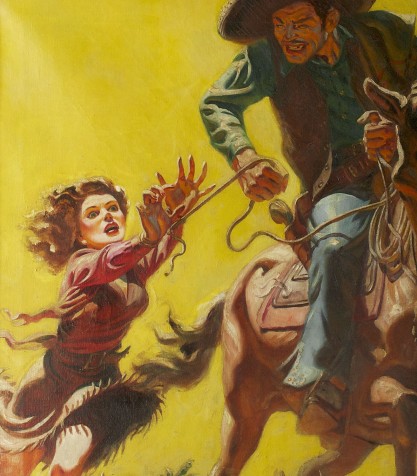

 |
| Above: Speed Western Stories, February 1943 (included in sale) |
This spicy pulp Western Americana themed oil painting by Allen Anderson was created as the cover of the February 1943 edition of Speed Western Stories, Volume #1 Issue #2 (Trojan Publishing, Chicago). A rare surviving example of lurid spicy pulp cover art, this was unearthed by Grapefruit Moon Gallery along with two additional original cover paintings by Allen Anderson that had for many years been displayed at the Cimarron Dude Ranch in Peekskill, New York. The dude ranch was known from the 1950s through the 1970s as an anything goes destination that catered to the rustic yet scandalous moods of New York City bohemians and artists. Anderson, who moved to the region in 1954, became friendly with the staff of Cimarron, and these were gifted by the artist to hang in the the ranch’s boisterous tavern confines. After Cimarron closed, the paintings were kept in the collection of one of the ranch’s managers until 2013. They have never been on the market prior to this offering.
As was often true with pulp covers, this image was created by Anderson before the contents of the magazine had been determined, though the image is loosely in keeping with the storyline of the title tale “Frisco or Bust”, by E. Hoffman Price.


This dynamic and subversive oil painting features the essential hallmarks of spicy pulp cover art: a peril-filled scene centered on a damsel in distress boldly captured and deftly rendered in a stark attention grabbing manner, so as to capture the eye of the potential newsstand buyer. The Spicy Western was a short lived pop culture phenomenon that used the lawless setting of the Old West as a way to hide in plain sight the subversive and often hyper-sexual content and imagery of the Spicys. The lurid, terrifying and often times violent Western Americana imagery played upon the darker impulses of readers, tapping into sexual fantasy and fetish. This image in particular exhibits themes of bondage and World War II-era fears of the “other,” as a tied up buxom pin-up cowgirl fights off an abduction by a stereotypically represented Mexican vaquero (cowboy).
This oil painting is in a very fine state of conservation and is one of the rare examples of the artist’s published pulp covers to emerge.
 |
| Above: Verso view of canvas with pine original stretchers |
 |
| Above: Verso detail |
Allen Anderson was born in Minneapolis, Minnesota in 1908. After taking two years of correspondence art courses, he took a job working for Fawcett Publications. In 1939, he moved to New York City to join his life-long friend and fellow illustrator Norman Saunders, working in a tight knit circle who called themselves the Bad Boys Group. Shortly after his move, however, it became clear that Anderson, along with many pulp illustrators, would be called up to service in World War II. Rather than lose the momentum he had begun building as an in-demand artist during the war, Anderson spent the next six months painting as many covers as he could, so that he could sell them throughout the war. This is one of the 57 pieces he created for titles such as Spicy Stories, Speed Western Stories, Spicy Western Stories, Spicy Mystery, Spicy Stories, Spicy Detective, and Super Detective during that period. A Navy man, Anderson spent the war teaching graphic design and lettering at a naval training camp in upstate New York–it is during this time he likely first visited the Cimarron Dude Ranch. After the war, he returned to work as a pulp artist for nearly a decade, retiring in 1954 when he left New York City permanently to return upstate with his new bride, Joan. Anderson died in 1995.
